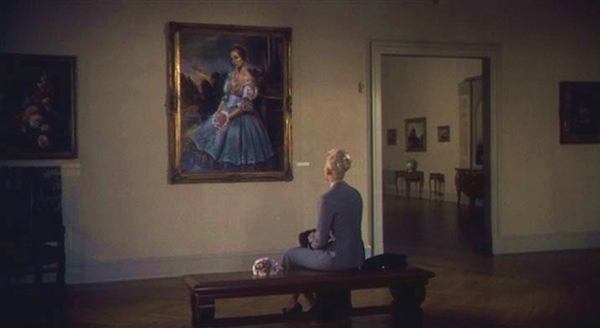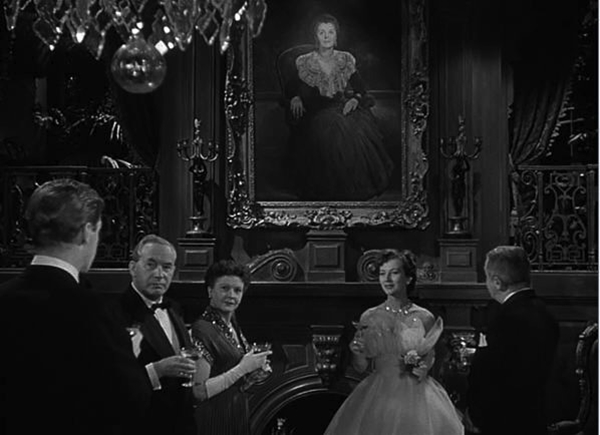Art World
New Film History Book Frames Artworks as the Stars of the Silver Screen
What are the masterpieces lurking within those dark and stormy classic films?

What are the masterpieces lurking within those dark and stormy classic films?

Graham Fuller


Kim Novak in “Vertigo.”
Steven Jacobs and Lisa Colpaert introduce The Dark Galleries, a book published by Aramer in the US on March 31, by observing how an English policeman in Alfred Hitchcock’s Suspicion (1941) pauses to look at a reproduction of Picasso’s 1931 cubist painting “Pitcher and Bowl of Fruit” in the home of a shady playboy (Cary Grant) and his potentially doomed wife (Joan Fontaine).
The moment contributes nothing to the advancement of the story but was almost certainly intended by Hitchcock as a joke on the suspicion in which modern art was then held by the masses. In the extensively illustrated book, Jacobs and Colpaert situated the Picasso amid 16 works by modern artists–among them Degas, Cézanne, Van Gogh, Klee, and Roualt–so disdained by “right-thinking’ people that they are owned by the evilly inclined.
The paintings that dominate The Dark Galleries, a nearly comprehensive study of the integration of art in film noirs, Gothic melodramas, and supernatural ghost stories in American and British films of the 1940s and 1950s, are bourgeois realist portraits–”most of them, bluntly, kitsch,” Jacobs writes. Frequently, however, directors and cinematographers, manipulating light and camera movement in their mise-en-scènes, endowed these undistinguished works (often painted photographs of the portrayed stars) with magical properties.
The book’s structure is ingenious. As its title suggests, it has been designed as a labyrinthine art museum–a discomfiting one given the filmic provenance of the paintings–that one can hold in one’s hand and browse at leisure. The six main galleries are arranged thematically: dying portraits (paintings as harbingers of death), patriarchs, matriarchs and female ancestors, ghosts, fatal portraits (femmes fatales and their ilk), and modern portraits. There are also galleries devoted to artists; museums and art galleries; collectors, critics, and connoisseurs; paintings concealing safes; and, as mentioned above, modern art hung in the homes of criminals.
Film and visual arts scholars based in Ghent, Jacobs and Colpaert developed the book, Jacobs says, from “a dictionary or encyclopedia of all artworks featured in films” that he and Colpaert had devised with silent cinema expert Vito Adriaensens. “We started assembling it, but after a couple of weeks we had a list of almost a thousand films. Quite early we saw that 95 percent of the artworks were portraits and that at certain moments in film history there are clusters and concentrations, like sculptures in early film and portraits in the ’40s. It became apparent that these paintings were very important to specific genres.” (Jacobs’s book on movie sculptures will follow next year.)
They rationalized the project into The Dark Galleries, wherein, “as in a museum guide, you can have masterpieces and secondary works, and you write, say, six pages on the masterpieces and only half a page or even less on the minor works–a flexible format. ” In the book’s “dying” section, the picture of Dorian Gray (Hurd Hatfield in the 1945 film of the Oscar Wilde novel) can be found near those of Johnny McQueen (James Mason in 1947’s Odd Man Out) and Fanny Trellis (Bette Davis in 1944’s Mr. Skeffington). Ghost paintings include portraits of the dead in The Uninvited (1944), Portrait of Jennie (1948), and Vertigo (1958). The most iconic gallery features paintings of the dangerous enchantresses in Laura (1944), The Woman in the Window (1944), and The Paradine Case (1947).

Gene Tierney and Dana Andrews in “Laura.”
Portraits of authoritarian patriarchs, dead or alive, meanwhile oppress the young in such films as Suspicion (1941), I Married a Witch (1942), Gilda (1946), House of Strangers (1949), Strangers on a Train (1951), and The Hound of the Baskervilles (1959). Canvases of matriarchs and other female ancestors disturb their inheritors and other vulnerable protagonists in the likes of Rebecca (1940), Now, Voyager (1942), Gaslight (1944), The Seventh Veil (1945), and The House on Telegraph Hill (1951).
Jacobs credits the proliferation of portraiture in noirs, melodramas, and supernatural films in the ’40s to “the new subjectivity that had emerged in American cinema, the influence and popularization of late Surrealism and its fascination for the portrait, and the awareness of the male gaze.” It’s no surprise that portraits in the films of Hitchcock and Fritz Lang, master manipulators of the gaze, are well represented in the book. In Lang’s The Woman in the Window and Hitchcock’s The Paradine Case, as in Otto Preminger’s Laura (1944), the act of looking at the portrait of a desirable woman emphasizes the male beholder’s inadequacies.
In Laura, a Manhattan detective (Dana Andrews) falls in love with the title character (Gene Tierney), whose murder he’s investigating, by gazing at the elegant portrait of her that hangs above her fireplace. Having fallen asleep in an armchair a few feet from it, he wakes to find that the real Laura–very much alive–has entered the room and is staring at him with mystification.
The middle-aged professor (Edward G. Robinson) in The Woman in the Window is similarly enchanted by the eponymous portrait exhibited in a gallery near East 44th Street. As he gazes at it, he realizes that the face of the sitter has appeared beside its image within the picture’s frame–a reflection of the seductress (Joan Bennett), a specter in glittering black who will lead him to hell. In Lang’s Scarlet Street (1945), Bennett plays the Greenwich Village prostitute who ensnares Robinson’s artist and signs his works (actually painted by John Decker), including his primitivist portrait of her that’s printed on the front page of the New York Times after he kills her.
Explaining why realistic paintings rather than modern art predominated in these films, Jacobs says, “I think all of these stories are about a portrait that is overwhelming. For the audience, but also probably for the producers of these films, a mesmerizing portrait had to be not simply realistic, but as if it were real. So that’s why they were painted in this illusionistic photographic way–in fact, many of them [including that of Tierney in Laura] were enlarged photographs that were varnished or painted over.”
“Their overwhelming quality has nothing to do with the pictorial power of the paintings,” he adds, “but is completely dependent on the optical tricks, sound effects, and camera movements. There’s a masterful scene, for instance, depicting the interaction between the young female beholder [Valentina Cortese] and the portrait of the murdered matriarch in The House on Telegraph Hill. Often, the paintings are fetishized by their lighting or the golden frames.” He alludes to the end of Scarlet Street when the Bennett portrait is brought onto the street, where light from the gallery and neon dances on it in front of the painter, by then a half-mad vagrant.
“Many of these films are dependent on the tension between the living person turned into an image, which is a kind of mortification,” Jacobs says, ” and the still image coming to life. Sometime directors and cinematographers play upon this tension, as in The Unsuspected [1947], which, like Laura, is a story about a woman [Joan Caulfield] who is supposed to be dead but isn’t. It starts beautifully with a nocturnal intruder in the house where the painting’s kept making it come alive with a flashlight. There’s something uncanny and foreboding about it.”

Valentina Cortese (center) in “The House on Telegraph Hill.”
Asked if he had thought of trying to bring the actual paintings together for a show to promote the book, Jacobs ruefully remarks, “That would be a very small exhibition. I think only three or four of them still exist. Most of them were destroyed. I know the one in Portrait of Jennie [painted by Robert Brackman and once owned by actress Jennifer Jones’s husband David O. Selznick, who produced the film] is in the Norton Simon Museum in Pasadena.
“The one of the disintegrating Dorian Gray [by Ivan Le Lorraine Albright] is in the Art Institute of Chicago,” Jacobs says. “I’ve heard that the portrait of Carlotta Valdes [by John Ferren] in Vertigo is in the office of the film’s most recent restorers, and some of the Dekkers from Scarlet Street survive.”
So no MoMA show then—but spectators can always gaze on “The Dark Galleries” and the troubling films that lend it its haunting and haunted art.